Copper Resources Strategy
Ok Tedi is not a single event, but a logical result of
the development of copper consumption, production, and mineral reserves.
Affi prepared its engagement in Ok Tedi Mine on a long term plan, knowing
very well what they were doing. This is documented in Ullmann's Encyclopedia
of Technical Chemistry. Ullmann's is a standard reference for German chemists,
and who else but an expert from Affi could write the chapter on copper?
The volume with Affi's contribution appeared in 1986, so it must be written
in the early 80ies. Based on an estimate of known and exploitable reserves
of 500,000,000 tons of copper, our expert predicted:
If one assumes that total production will remain stable, the identified
resources would last until ca. 2050. ...the dynamic approach, which assumes
that production will increase at the rate it has in recent years, would
reduce the duration of known reserves by nearly half. ... However, all
these forecasts are quite unreliable.
One tendency, that makes forecasts variable, is what is regarded "exploitable".
Around 1900 ores contained 5% Cu, 1980 a minimum of 0.5% Cu appeared profitable
(at Ok Tedi the mean content is 0.8%). By improvement of flotation techniques
even lower contents will be accepted. However, the mere amount of dead
rock, flotation water, and tailings will become the problem.
In a rough estimate, since 1982 150 million tons of copper were withdrawn
from the 500 million t reserve (s.a.) by the world's consumption. On the
other hand, new reserves were discovered, as Affi's chairman Dr. Marnette
pointed out. Since 40 years, world reserves are predicted to last for 30
years (assuming dynamic growth of consumption)! According to Affi's prediction,
concentration of copper in these ores will be lower than that of the past.
However, this seems to be a long term tendency, but not the rule for the
new deposits found recently. There has been always sufficient copper ore
concentrate on the market. Even the gap left, when the large mine on Bougainville
was shut because of the civil war, was filled instantly. Copper supply
is not at risk, neither because of scarce reserves, nor for political reasons
like the oil crisis of 1973. This means, the price of ore concentrate is
low.
If standards for the treatment of waste were kept high, low grade ore
and ore mined in tropical and mountainous environments like on Newguinea,
would be more costly. Companies save cost for environmental protection,
unless forced by state. The less developed a country, the weaker command
and control. Except USA and Canada, the copper mining states' do not have
the power, to deny the demands of the mining companies.
Have a look at the figures (from Electronic Arts 3DAtlas)
Masses calculated as Cu
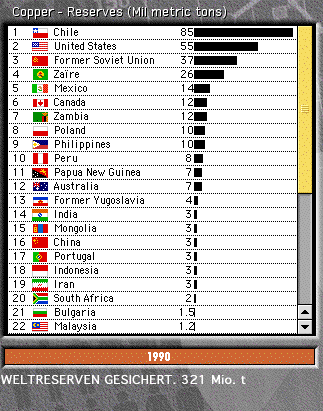
Reserve estimates have to be taken with caution!
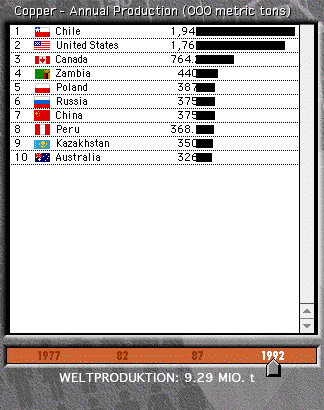
World mining production
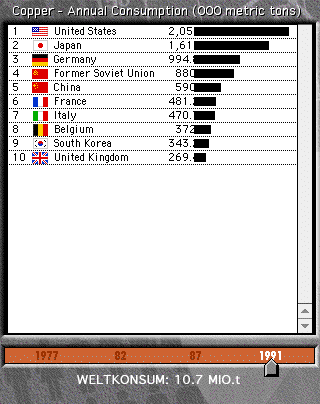
World copper consumption - this figure includes the use of recycled scrap
metal, so it is higher than production from mines
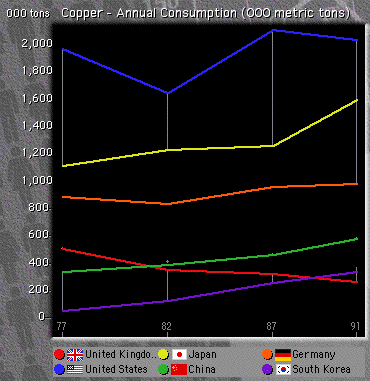
World consumption steadily increased in the period displayed. The decrease
of UK is problably due to a major restructure of heavy industries.
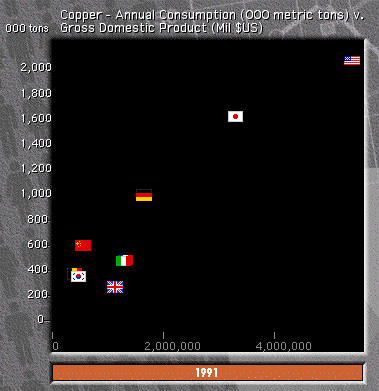
In general, copper consumption is directly related to the gross domestic
product.
Still market demand increases, in Europe by 20% till 2005. The capacity
to process concentrate at Affi's will be enlarged by 30% in 2000.
Now imagine China's economy to grow to US-size, which is not unprobable.
Copper consumption would increase by 1.5 million tons/year. Imagine further,
1.5 billion Chinese working as productive as 0.2 billion US-inhabitants,
which is not impossible, and demand 15 million tons of copper! Add India's
1 billion people, that simply does not appear in the graphics, because
the figures are not at hand. So the question arises, how long would reserves
last, even if one adds undiscovered deposits on the ocean floor?
In the long run, increasing demand will cause copper ore to become
scarce and expensive, to allow more environmental protection, or more recycling
of scrap. Before we arrive at this level, however, mines like Ok Tedi will
be exhausted, leaving environment destroyed. Market will not enforce a
solution today and in the next decade. Political decisions have to be made,
to impose common regulations for mining, and to empower developing countries
to exercise them on the companies. These, of course, do not like laws,
but offer a voluntary code of conduct. The alternatives will be discussed
in a following chapter.
Though Affi bought the largest scrap copper smelter of Europe, Kayser
at Lünen, Germany, to concentrate the scrap busíness there,
the overall capacity for recycling will not grow. Worldwide 10% (Europe
15%) of copper production come from scrap metal. Considered the production
since World War II, the copper inventory of the world equals the reserves
in ore deposits. Because many copper products have a long life, they are
available to recycling much later. An increasing share of copper in short
lived devices like cellular phones will change this situation. Facing future
demand. and a limited and continuously exhausted reserve of prime copper,
we have to recognize, that the only sustainable copper source is the copper-inventory
in goods, which are already produced.
 Index
of Ok Tedi pages Index
of Ok Tedi pages
 back
to Homepage back
to Homepage |